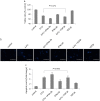Regulation of transforming growth factor is involved in the efficacy of combined 5-fluorouracil and interferon alpha-2b therapy of advanced hepatocellular carcinoma
- PMID: 29560281
- PMCID: PMC5849890
- DOI: 10.1038/s41420-018-0040-y
Regulation of transforming growth factor is involved in the efficacy of combined 5-fluorouracil and interferon alpha-2b therapy of advanced hepatocellular carcinoma
Abstract
Transforming growth factor-beta (TGF-β) is critical in cancer cell invasion and metastasis. The effects of a treatment that targets TGF-β using the combination of interferon alpha (IFNα)-2b and 5-fluorouracil (5-FU) are unknown. Here, we show that the serum levels of TGF-β1 prior to the therapy correlate with increased maximum tumor diameter, which is significantly (p < 0.01) decreased after the combination therapy. 5-FU increased both the expression and secretion levels of TGF-β1 in hepatoma cells, but not in normal hepatocytes. The combination of 5-FU and IFNα-2b synergistically affected cell death. However, a TGF-β1 specific inhibitor did not affect the anti-tumor activity of 5-FU. 5-FU inhibited the phosphorylation of SMAD2 and reduced the total protein levels of SMAD2, SMAD4, and pINK4b. Conversely, 5-FU stimulated the phosphorylation of extracellular signal-regulated kinase (ERK)1/2. Accordingly, the protein levels of E-cadherin and claudin-1 were reduced in 5-FU-treated cells. The combination of 5-FU and IFNα-2b, and the inhibition of ERK1/2 by a specific inhibitor neutralized the effects of 5-FU on TGF-β-related signaling molecules and restored their protein levels to those observed in the control. Interestingly, the phosphorylated protein levels of SMAD2 and the total protein levels of E-cadherin and p15INK4b were increased in 5-FU-stimulated HuH-7 cells, but not in Hep G2 cells. Our data suggest that the higher efficacy of the 5-FU and IFNα-2b combination therapy was associated with the regulation of TGF-β expression, secretion, and the signals mediated by it.
Conflict of interest statement
The authors declare that they have no conflict of interest.
Figures






Similar articles
-
Role of the Fas/FasL pathway in combination therapy with interferon-alpha and fluorouracil against hepatocellular carcinoma in vitro.J Hepatol. 2007 Jan;46(1):77-88. doi: 10.1016/j.jhep.2006.07.032. Epub 2006 Sep 25. J Hepatol. 2007. PMID: 17045692
-
Combination of 5-FU and IFNalpha enhances IFN signaling pathway and caspase-8 activity, resulting in marked apoptosis in hepatoma cell lines.Int J Oncol. 2006 Nov;29(5):1253-61. Int J Oncol. 2006. PMID: 17016659
-
Involvement of smad2 and Erk/Akt cascade in TGF-β1-induced apoptosis in human gingival epithelial cells.Cytokine. 2015 Sep;75(1):165-73. doi: 10.1016/j.cyto.2015.03.011. Epub 2015 Apr 14. Cytokine. 2015. PMID: 25882870
-
Activation of extracellular signal-regulated kinase by TGF-beta1 via TbetaRII and Smad7 dependent mechanisms in human bronchial epithelial BEP2D cells.Cell Biol Toxicol. 2007 Mar;23(2):113-28. doi: 10.1007/s10565-006-0097-x. Epub 2006 Nov 9. Cell Biol Toxicol. 2007. PMID: 17096210
-
The antifibrotic effects of relaxin in human renal fibroblasts are mediated in part by inhibition of the Smad2 pathway.Kidney Int. 2005 Jul;68(1):96-109. doi: 10.1111/j.1523-1755.2005.00384.x. Kidney Int. 2005. PMID: 15954899
Cited by
-
Oncogenic Pathways in Neurodegenerative Diseases.Int J Mol Sci. 2022 Mar 17;23(6):3223. doi: 10.3390/ijms23063223. Int J Mol Sci. 2022. PMID: 35328644 Free PMC article. Review.
-
TGF-β Signaling and Resistance to Cancer Therapy.Front Cell Dev Biol. 2021 Nov 30;9:786728. doi: 10.3389/fcell.2021.786728. eCollection 2021. Front Cell Dev Biol. 2021. PMID: 34917620 Free PMC article. Review.
-
Extracellular vesicles secreted by equine adipose mesenchymal stem cells preconditioned with transforming growth factor β-1 are enriched in anti-fibrotic miRNAs and inhibit the expression of fibrotic genes in an in vitro system of endometrial stromal cells fibrosis.Vet Q. 2024 Dec;44(1):1-11. doi: 10.1080/01652176.2024.2384906. Epub 2024 Jul 31. Vet Q. 2024. PMID: 39086189 Free PMC article.
-
Stimulating Antitumoral Immunity by Percutaneous Cryoablation and Combination Immunoadjuvant Therapy in a Murine Model of Hepatocellular Carcinoma.J Vasc Interv Radiol. 2023 Sep;34(9):1516-1527.e6. doi: 10.1016/j.jvir.2023.05.008. Epub 2023 May 11. J Vasc Interv Radiol. 2023. PMID: 37178816 Free PMC article.
-
Role of exosomes in transforming growth factor-β-mediated cancer cell plasticity and drug resistance.Explor Target Antitumor Ther. 2025 Jun 5;6:1002322. doi: 10.37349/etat.2025.1002322. eCollection 2025. Explor Target Antitumor Ther. 2025. PMID: 40486962 Free PMC article. Review.
References
LinkOut - more resources
Full Text Sources
Other Literature Sources
Miscellaneous

